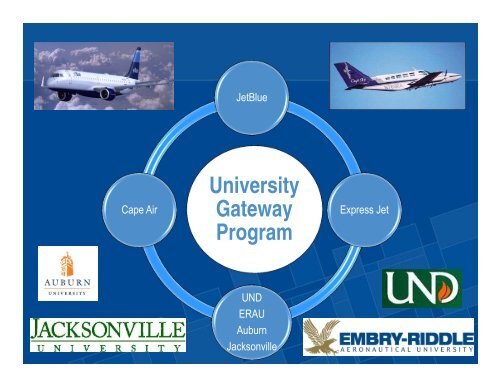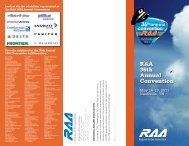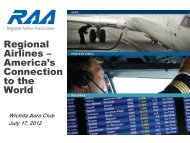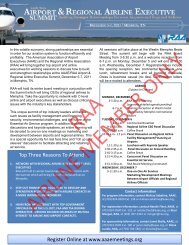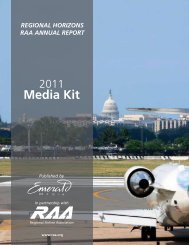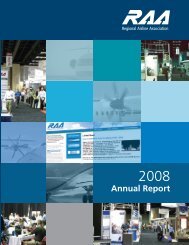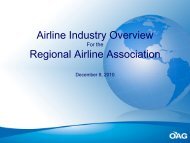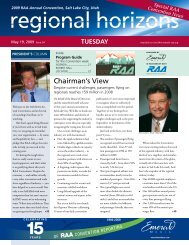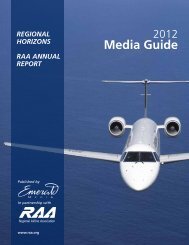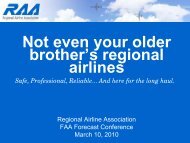Presentation - Regional Airline Association
Presentation - Regional Airline Association
Presentation - Regional Airline Association
Create successful ePaper yourself
Turn your PDF publications into a flip-book with our unique Google optimized e-Paper software.
JetBlue<br />
Cape Air<br />
University<br />
Gateway<br />
Program<br />
Express Jet<br />
UND<br />
ERAU<br />
Auburn<br />
Jacksonville
University Gateway Program Objective<br />
To provide a defined pathway for AABI-accredited program<br />
aviation students to become pilots at JetBlue Airways, allowing<br />
them to continually develop skills and professionalism with an<br />
understanding of JetBlue’s values through regional airline<br />
experience, mentoring and internships<br />
Known training, experience and a common culture
Why the Gateway Program?<br />
• There have not been pathways to a major<br />
airline that provide ALL of the following:<br />
− Foundational Learning at an AABI-<br />
Accredited Program<br />
− Program entry in Sophomore Year<br />
− Structured Flight Training<br />
− Industry Internships<br />
− Flight instructor experience<br />
− Part 135 <strong>Airline</strong> Flying experience<br />
− Professional Mentorship<br />
• JetBlue helps develop their future<br />
pilots
Current Model to Become an <strong>Airline</strong> Pilot<br />
College? Part 61 or 141 Hour Building<br />
No Blueprint or Defined Path<br />
Training Complete at 300 hours. Where does a pilot get valuable<br />
flight time in next 1200 hours and at what cost?<br />
Instructor or Part 135<br />
Corporate or <strong>Regional</strong><br />
Right Seat<br />
Possibly a number of<br />
airlines<br />
Major<br />
3-7 years of Unknown Experience<br />
1-2 Years - No Feedback or Mentoring After 11-15 years<br />
•What values are expected of the pilot?<br />
•How do we account for quality of training?<br />
•How do we know the pilot’s experience?
JetBlue’s University Gateway Program<br />
Defined Path for a Professional Pilot<br />
Freshman Sophomore Junior Senior 800-1200tt<br />
Year Year Year Year<br />
AABI<br />
Accredited<br />
Program<br />
Acceptance‐<br />
Mentor<br />
Assignment<br />
Internship<br />
University<br />
Degree/<br />
Ratings<br />
CFI<br />
Year 1<br />
Age 23<br />
Year2 Year 3 Year 4 Year 5<br />
1500 Hrs.<br />
<strong>Regional</strong> Partner –<br />
Cape Air Captain<br />
2‐3 Years 2400 Hrs.<br />
Jet<br />
Transition<br />
Course<br />
JetBlue<br />
Final<br />
Interview<br />
Year 6 Year 7 Year 8<br />
Age 27<br />
4000 Hrs.
JetBlue’s University Gateway Program<br />
A Defined Path for a Professional Pilot<br />
Freshman Sophomore Junior Senior Year<br />
Year<br />
Year Year 800-1200tt<br />
AABI<br />
Accredited<br />
Program<br />
Acceptance‐<br />
Mentor<br />
Assignment<br />
Internship<br />
University<br />
Degree/<br />
Ratings<br />
Instruct at<br />
University<br />
OR<br />
Year 1<br />
<strong>Regional</strong> Partner –<br />
Cape Air<br />
2‐3 year as a Captain<br />
<strong>Regional</strong> Partner Cape<br />
Air<br />
1 year as a Captain<br />
Year2 Year 3 Year 4 Year 5<br />
Jet<br />
Transition<br />
Course<br />
<strong>Regional</strong> Partner<br />
Express Jet<br />
2 Years<br />
Year 6 Year 7 Year 8<br />
JetBlue<br />
Final<br />
Interview<br />
Age 23<br />
1500 Hrs.<br />
Age 27<br />
4000 Hrs.
Benefits to Students and Universities<br />
• Student Benefits<br />
− Defined Path with clear and obtainable goals<br />
− Valuable flight time as a CFI and strong interpersonal skills<br />
− Decision making and airmanship as Captains at Cape Air<br />
− Option to fly a larger regional Jet with Express Jet<br />
• University benefits:<br />
− Fostering Relationships with Industry<br />
− Recruitment and marketing to future students<br />
− Value of AABI Accreditation<br />
− Retaining flight instructors to teach the next generation
Benefit to <strong>Airline</strong> Partners<br />
• <strong>Regional</strong> partners<br />
− Provides a steady stream of qualified and motivated pilots<br />
− Enhances safety by attracting pilots from top universities<br />
− A relationship starts early - you know a future employee’s values<br />
• JetBlue Airways<br />
− Mentors nurture development of “Values-Minded” professionals<br />
− Allows continuous evaluation and observation of pilot candidates<br />
during their professional development<br />
− Provides metered flow of qualified and experienced pilots for<br />
JetBlue to support recruitment goals
Program Success<br />
• Program launched in 2007<br />
− 147 pilots in the program<br />
− 8 Gateway Pilots are now JetBlue Airways First Officers<br />
− 20+ Gateway Pilots flying for Cape Air<br />
− Over 75 internships completed at Cape Air and JetBlue<br />
Real Success of the Program:<br />
Developing and sustaining a relationship with a young aviator<br />
early in his or her career, providing mentoring and guidance to<br />
develop a professional and values-minded airline pilot
Thank You
An Investigation of the United<br />
States <strong>Airline</strong> Pilot Labor Supply<br />
Copyright 2013 © By the Authors
The Research Team<br />
UND:<br />
James Higgins<br />
Kent Lovelace<br />
Elizabeth Bjerke<br />
Nick Lounsberry<br />
UAA:<br />
Bruce Chase/ LeTourneau Univ.<br />
AABI:<br />
Paul Craig/ MTSU<br />
ERAU:<br />
Daniel Friedenzohn<br />
UNO:<br />
Rebecca Lutte<br />
SIU:<br />
Sam Pavel<br />
Numerous Industry Representatives<br />
Copyright 2013 © By the Authors
Reasons for the study<br />
• Request from Industry Stakeholders Group<br />
• Provide data to GAO if they embarked on a<br />
study<br />
• More data on the effects of FOQ<br />
• Recent hiring trends with the regional airlines<br />
Copyright 2013 © By the Authors
People Interested in Aviation<br />
Company Sponsored Foreign Pilots<br />
Other than consumer<br />
decision<br />
Consumer Decision<br />
(Risk vs. Reward)<br />
New Commercial Pilots<br />
Foreign Pilots<br />
Return to<br />
Home Country<br />
New Non‐<br />
<strong>Airline</strong> Pilots<br />
(Military, Corporate,<br />
etc.)<br />
New Certified Flight Instructors<br />
New <strong>Airline</strong><br />
Pilots<br />
Military Pilots<br />
Copyright 2013 © By the Authors
Commercial Pilot Written Examinations by Citizenship<br />
7000<br />
US and Foreign Citizens Completing the Commercial Airplane Written<br />
50%<br />
6000<br />
45%<br />
40%<br />
5000<br />
35%<br />
4000<br />
3000<br />
30%<br />
25%<br />
20%<br />
2000<br />
15%<br />
1000<br />
10%<br />
5%<br />
0<br />
2004 2005 2006 2007 2008 2009 2010 2011 2012<br />
0%<br />
US Citizens Foreign Citizens Percentage Source: FAA Knowledge Test Data<br />
Copyright 2013 © By the Authors
New CFIs<br />
– Using the supply model, newly trained CFIs will<br />
become available to help mitigate supply losses<br />
– Using the most recent data from the UAA/AABI<br />
Survey (n=1636), only 53.67% of CFIs intend to fly<br />
for the airlines as a long‐term career goal<br />
– After certification, it is assumed that an additional<br />
2 years of flight instruction will be needed to<br />
achieve restricted ATP minimums<br />
• 1000 hours<br />
• Effects of Cross‐Country Requirements 5 to 1<br />
• Effects of overall flight training activity<br />
Copyright 2013 © By the Authors
4000<br />
Forecast Yearly and Cumulative Shortages of Pilots to Staff the US<br />
<strong>Airline</strong> Fleet<br />
40000<br />
3500<br />
35000<br />
3000<br />
30000<br />
Yearly Number of Pilots<br />
2500<br />
2000<br />
1500<br />
1000<br />
25000<br />
20000<br />
15000<br />
10000<br />
Cumulative Number of Pilots<br />
500<br />
5000<br />
0<br />
2013 2014 2015 2016 2017 2018 2019 2020 2021 2022 2023 2024 2025 2026 2027 2028 2029 2030 2031<br />
0<br />
Yearly Shortage<br />
Cumulative Shortage<br />
Copyright 2013 © By the Authors
Summary of Forecast 2013‐2031<br />
– Potential deficit of 35,059 unless mitigation strategies<br />
are put in place<br />
– Considers pilots leaving the industry and pilots joining<br />
the industry on a yearly basis<br />
– Holds all other Commercial and ATP pilots constant<br />
– Does not consider impact of:<br />
• Flight‐Time/Duty‐Time Rules<br />
• Foreign <strong>Airline</strong> Hiring<br />
• Potential PL 111‐216/FOQ Rule impact of an additional<br />
candidates abandoning airline career<br />
Copyright 2013 © By the Authors
Potential PL 111‐216/FOQ Rule impact of an<br />
additional candidates abandoning airline<br />
career<br />
• UAA/AABI Survey<br />
– 1,600+ participants<br />
– 40 different education/training institutions<br />
– Up to an additional 32.53% candidates may<br />
rethink their plans to become an airline pilot<br />
– 8.32% of candidates have already changed their<br />
minds to pursue an airline career due to this law<br />
Copyright 2013 © By the Authors
UND Follow On Survey<br />
• 205 responses<br />
• 80% indicated they planned to obtain or have<br />
a CFI certificate<br />
• 57% indicated they were pursuing an airline<br />
career<br />
Copyright 2013 © By the Authors
UND Follow On Survey<br />
Copyright 2013 © By the Authors
UND Follow On Survey<br />
• What would it take to convince you to<br />
consider an airline career?<br />
• Major Themes<br />
– Salary<br />
– Lifestyle/Family/Location<br />
– Work Schedule<br />
– P.L. 111‐216/1500 hour requirement<br />
Copyright 2013 © By the Authors
Mitigation Strategies<br />
• Increase the supply of CFIs willing to pursue an <strong>Airline</strong><br />
career greater than the current 53.67%<br />
– Actively recruit and persuade new pilots to consider an<br />
airline career<br />
– Focus group survey to determine particulars of life style<br />
issues and salary issues<br />
– Offer defined career paths (Gateway/Pathway/Pipeline)<br />
– Faculty Development Program<br />
• Reduce the cost/debt of obtaining pilot<br />
Certificates/Ratings<br />
– Loan consolidation<br />
– Supplement financial aid payments<br />
– Salaries<br />
Copyright 2013 © By the Authors
Mitigation Strategies<br />
• All Parties need to participate to promote a<br />
more positive image of an airline career<br />
– Education<br />
– <strong>Airline</strong>s<br />
– Labor<br />
• ALPA ACE Program<br />
– Pilots promoting the profession<br />
• How we look<br />
• How we fly<br />
• How we interact with others<br />
Copyright 2013 © By the Authors
Thank You<br />
Copyright 2013 © By the Authors
Assessing New Pilot Challenges<br />
“Outreach”<br />
Captain Darrin Greubel<br />
ExpressJet <strong>Airline</strong>s
• An Industry at a crossroads…….<br />
- Regulation<br />
-Growth<br />
- Retirement<br />
• Awareness and Understanding<br />
- Strength in numbers – Pilot Supply Consortium<br />
- Communicating with political leadership<br />
- FAA / GAO / House / Senate / OMB<br />
27
• A better understanding…….<br />
- Pilot supply verses pilot demand<br />
- Constraints<br />
- The need for an objective “all encompassing” study<br />
• GAO Study<br />
• University research and investigation<br />
• Private studies<br />
28
• Education<br />
– AABI / UAA<br />
– WATS / RATS<br />
– NTAS<br />
– RAA<br />
– Supply and Demand Symposium<br />
29
Questions?


